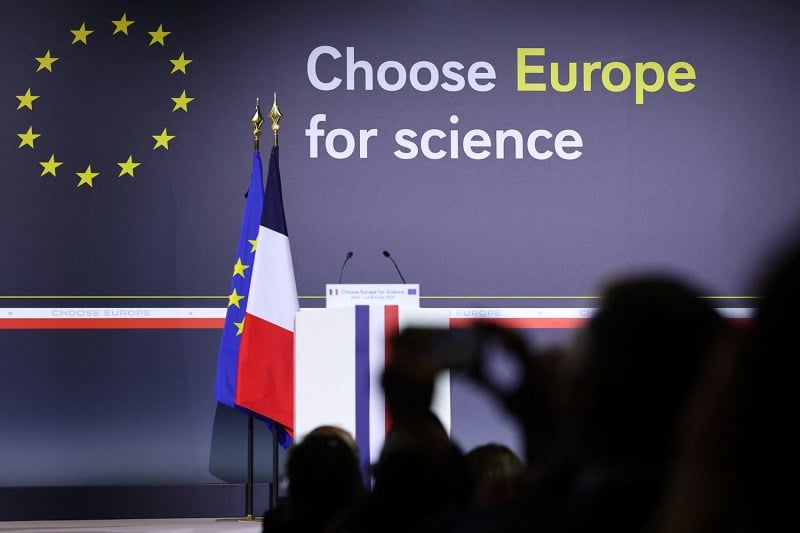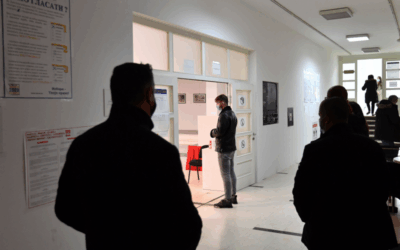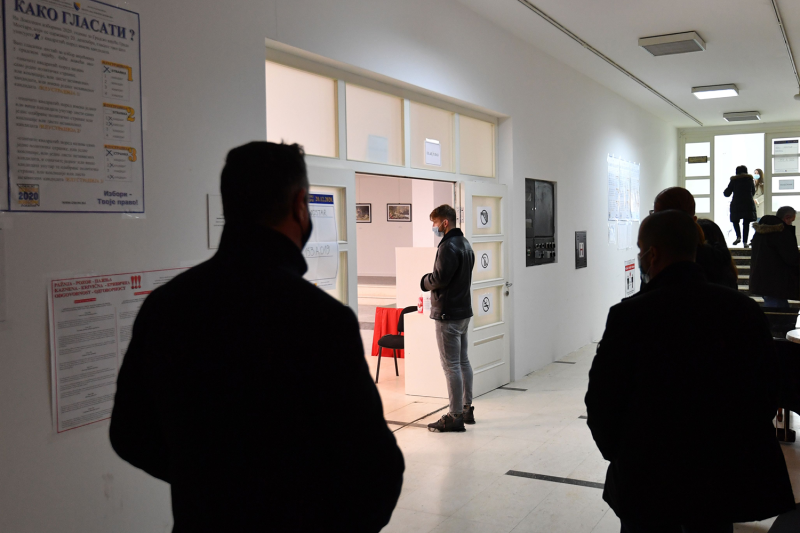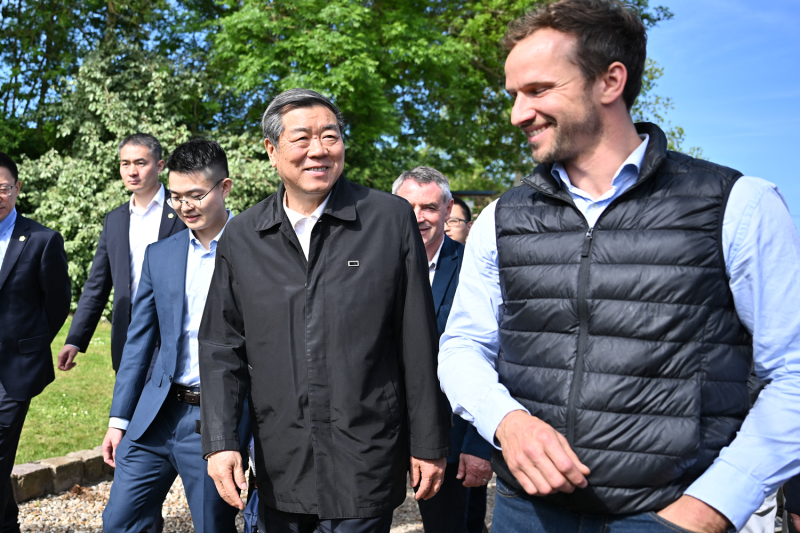Trump’s Brain Drain Will Be Europe’s Gain

Trump’s Brain Drain Will Be Europe’s Gain
Brussels and London should go big on siphoning American science and technology talent.
The stage of the Choose Europe for Science conference at Sorbonne University in Paris on May 5. Gonzalo Fuentes/Pool/AFP via Getty Images
French President Emmanuel Macron hosted a conference at Sorbonne University in early May aimed at attracting U.S. scientists to France. European Commission President Ursula von der Leyen gave him an assist, announcing a two-year, 500 million euro ($556 million) effort to support U.S. scientists moving to Europe. It’s a smart start, but Europe should go bigger—much bigger—to take advantage of the Trump administration’s monumental own goal of attacking the U.S. scientific, technical, and broader academic research communities just as global competition around cutting-edge innovation accelerates.
While cozying up to Russia, starting a global trade war, and threatening to annex the United States’ closest neighbor have gotten more attention, among U.S. President Donald Trump’s most consequential actions for the United States’ long term international power has been the assault on science at home. By slashing federal funding for basic research, mounting attacks against universities, and sowing chaos in the visa system for foreign students, Trump has undermined one of the United States’ most important strategic advantages: the best basic research ecosystem in the world, one that drives U.S. commercial innovation and competitive success.
French President Emmanuel Macron hosted a conference at Sorbonne University in early May aimed at attracting U.S. scientists to France. European Commission President Ursula von der Leyen gave him an assist, announcing a two-year, 500 million euro ($556 million) effort to support U.S. scientists moving to Europe. It’s a smart start, but Europe should go bigger—much bigger—to take advantage of the Trump administration’s monumental own goal of attacking the U.S. scientific, technical, and broader academic research communities just as global competition around cutting-edge innovation accelerates.
While cozying up to Russia, starting a global trade war, and threatening to annex the United States’ closest neighbor have gotten more attention, among U.S. President Donald Trump’s most consequential actions for the United States’ long term international power has been the assault on science at home. By slashing federal funding for basic research, mounting attacks against universities, and sowing chaos in the visa system for foreign students, Trump has undermined one of the United States’ most important strategic advantages: the best basic research ecosystem in the world, one that drives U.S. commercial innovation and competitive success.
This ecosystem is underwritten by the United States’ ability to attract, develop, and retain a significant share of the world’s top researchers, and it thrives in a country where intellectual property rights and rule of law are upheld, and academic freedom is protected and respected.
The European Union and its member countries—together with the United Kingdom and perhaps Canada—should work together to create a research investment fund with an initially available drawdown of $20 billion to buy U.S. scientific and technological research labs. The fund could be chaired by a former finance minister and advised by small boards made up of private sector and academic leaders connected to specific areas of research—including biotech, artificial intelligence (AI), pharmaceuticals and medical research, and energy—that help make investment decisions. The idea would be to make quick investments at current run rates for lab and research group operations, with similar intellectual property arrangements to their current arrangements with U.S. universities and federal research facilities.
Where practical, the fund could offer to move these labs to European universities or research centers. In some cases, it will make sense for some of the labs to continue working, at least for the time being, in the United States. But these labs can be integrated more fully into the European research landscape over time.
One of the challenges with the initiative announced by von der Leyen this week—in addition to the fact that it needs to be bigger—is that it’s difficult for a single U.S.-based scientist to pick up and move, find another compatible research group across the ocean, and arrange funding. Johns Hopkins University, famous for its medical and public health research, recently announced the layoffs of 2,000 people involved in public health work. Europe should be ready to scoop up that talent in buckets when it comes on the market.
Investments in basic science and research don’t pay dividends in the short term. The consequences of the Trump administration’s attacks won’t be seen in next year’s initial public offerings–they’ll be seen in a less dynamic and innovative U.S. economy 20 years from now. It takes a decade or more for a new discovery to go through testing and development and be brought to market. Over the long run, these investments can lay a foundation for European competitiveness and innovation.
Scientific research labs aren’t the only fount of talent that Europe can harvest at this Trumpian moment. Attracting immigrants from the United States who are likely to found or join start-ups, contribute to European companies, and generally add to the skilled workforce should also be a priority.
Immigration has been crucial to U.S. innovation and economic success. A recent study found that two-thirds of Silicon Valley tech workers are foreign born. The Trump administration’s deportations of lawful permanent residents and student visa holders have made the United States less attractive as a destination for talent. And paired with the attacks on research communities and other actions, they’ve made native talent more open to leaving. After 15 years of having more AI talent coming into the United States than leaving, Semafor recently found that for the first time, inflow and outflow are now about equal. It’s not hard to see the country becoming a net exporter of AI talent in the next 24 months while the competition with China intensifies.
To take advantage of Trump’s actions, the EU should fast-track a new scheme—let’s call it a blue-and-yellow card—that is available to any U.S. citizen or green card holder with a graduate degree and $50,000. Such a card could provide for residency with permission to work until, say, Jan. 20, 2029, with a possible extension for those who are employed on that date. The design and marketing of this scheme are as important as the reality of it—it won’t work if there are too many complicated conditions or bureaucratic rules. The plan has to be something that could be put on a billboard so that Americans seeking to relocate are able to understand quickly that this is a straightforward option. A big, bold offer will get more news coverage, more water cooler and dinner table conversations, and more attention from skilled workers.
Europe could lure many thousands of these workers, who are likely to quickly contribute to European economies and tax receipts. Yes, salaries are lower in Europe, but the quality of life is good, and social safety nets and accessible health care are part of the European offer. Many people are likely to stay for the long run, becoming new Europeans who inject skills, entrepreneurialism, and diversity into the continent’s advanced democracies.
Economic competition in the 21st century and the geopolitical consequences that flow from it will hinge on the marriage of talent and technology. Productivity gains from AI, breakthroughs in medical research, cheaper and more sustainable energy sources, and advanced materials and manufacturing all hold promise for helping people to lead richer, healthier lives. While the United States has struggled to make progress in primary and secondary education over the past half century, its university system—including both the research and the degree granting functions—has remained the most robust in the world.
As Americans grapple with Trump’s fire hose of chaos, Europeans are increasingly clearheaded about the fact that their relationship with the United States has fundamentally changed and cannot easily be rebuilt, no matter what the future brings. In setting themselves up for a new world where the United States is no longer any sort of dependable partner, it would make sense for them to be more aggressive toward their erstwhile ally—and that includes being ruthless about capitalizing on U.S. mistakes.
Trump’s folly can be Europe’s gain, and bold moves by European leaders could make American talent part of a European competitive edge in the coming decades.
This post is part of FP’s ongoing coverage of the Trump administration. Follow along here.
Daniel B. Baer is the senior vice president for policy research at the Carnegie Endowment for International Peace, a former U.S. ambassador to the Organization for Security and Cooperation in Europe from 2013 to 2017, and the author of The Four Tests: What it Will Take to Keep America Strong and Good. X: @danbbaer
More from Foreign Policy
-

Indian Air Force personnel stand in front of a Rafale fighter jet during a military aviation exhibition at the Yelahanka Air Force Station in Bengaluru. A Tale of Four Fighter Jets
The aircraft India and Pakistan use to strike each other tell a story of key geopolitical shifts.
-

A cardinal in a black robe with red sash with hands folded in front of him walks past a stage and steps. Conclave Sends Message With American Pope
Some cardinals had been agitating for U.S. leadership to counter Trump.
-

An illustration shows red tape lines crossing over and entrapping a semiconductor chip. Is It Too Late to Slow China’s AI Development?
The U.S. has been trying to keep its technological lead through export restrictions, but China is closing the gap.
-

A man watches a news program about Chinese military drills surrounding Taiwan, on a giant screen outside a shopping mall in Beijing on Oct. 14, 2024. The Pentagon Fixates on War Over Taiwan
While U.S. military leaders fret about China, Trump has dismissed the Asia-Pacific.







Join the Conversation
Commenting on this and other recent articles is just one benefit of a Foreign Policy subscription.
Already a subscriber?
.
Subscribe
Subscribe
View Comments
Join the Conversation
Join the conversation on this and other recent Foreign Policy articles when you subscribe now.
Subscribe
Subscribe
Not your account?
View Comments
Join the Conversation
Please follow our comment guidelines, stay on topic, and be civil, courteous, and respectful of others’ beliefs.
Change your username |
Log out
Change your username:
CANCEL
Confirm your username to get started.
The default username below has been generated using the first name and last initial on your FP subscriber account. Usernames may be updated at any time and must not contain inappropriate or offensive language.